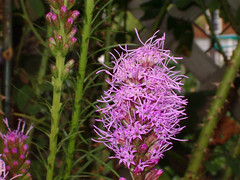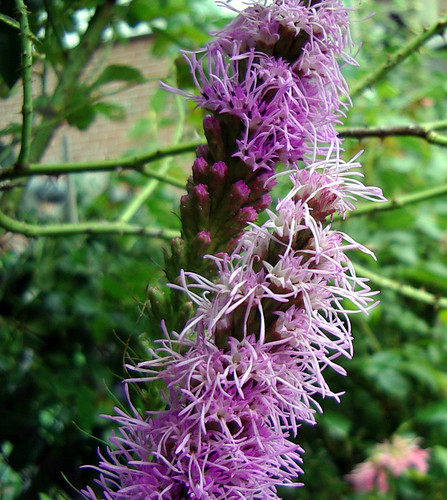Since so many people asked about the Liatris photo that I posted last week I thought I’d tell you more about this beautiful perennial.
 The Gayfeather, Liatris spicata is an interesting perennial perennial which produces a 1-3 foot tall spike of bright purplish-pink or white flowers in late June to early fall. It is an ideal plant to grow in your butterfly garden.
The Gayfeather, Liatris spicata is an interesting perennial perennial which produces a 1-3 foot tall spike of bright purplish-pink or white flowers in late June to early fall. It is an ideal plant to grow in your butterfly garden.
The Liatris is hardy to USDA zones 3 to 10.
The Gayfeather performs best when it is grown in full sun, but will tolerate a bit of light shade.
Liatris does not like soggy soil during the winter months so good drainage is extremely important. Once established, it is fairly drought tolerant. The Liatris will tend to develop mildew if it has insufficient sunlight and air circulation, so be sure to give it plenty of room.
Gayfeather may be started from seeds, sown indoors at 65-75 degrees or directly into the garden in early Spring, but they will not bloom until their second year. Germination takes from 20 to 45 days. I actually purchased mine as tuberous corms, planting them in the spring and getting some flowering in the first year. The Liatris in my garden is established now and tends to give off a beautiful light purple display from July into September.
Large clumps should be dug and divided in the Spring, every three to four years. The divisions, or other new plants should be set 15 inches apart, in rich, slightly sandy soil.
The genus Liatris belongs to the Asteraceae, or aster family, and is composed of around 40 different species. Common names include gayfeather and blazing star. Most of the species are prairie or grassland natives and have stiff, erect, two- to five-foot stems and grass like leaves. The flowers (technically “flower heads” composed of multiple florets, or tiny flowers) are generally wispy purple, sometimes white, and they cover the top third of the stems in dense clusters from early summer to late fall, depending on the species.
One of the reasons gayfeathers are such popular cut flowers is their unusual mode of blooming. Unlike most plants with a similar inflorescence, they bloom from the top of their flower spikes downward. You can actually cut a good portion off the top of the spike (again about a third) to bring indoors, and the remaining flower heads will continue to open and add color to the garden.
Because of their vertical nature, Liatris species take up minimal space and are suitable for even the smallest garden. They are equally at home in large, established perennial borders, where their thin, tall, airy floral wands create a mesmerizing “pop-up” effect.
Besides getting a visual boost, your garden will also hum delightfully from the various insect pollinators that come to feed on Liatris flowers. Butterflies are particularly attracted to the nectar-rich blossoms. Birds will also pay a visit as they relish the fall-ripening seeds.
Drought tolerance is an especially desirable trait that Liatris species offer. Their water-retentive corms allow them to persist in lean, dry times. And cultivation is very straightforward. Most gayfeathers prefer full sun and well-drained soil of moderate to lean fertility. I have never encountered any insect or disease problems. In fact, I can’t think of a reason not to grow these plants!
